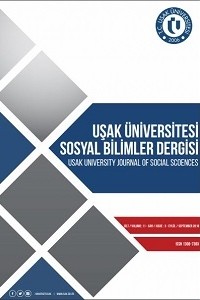İstatistik'ten Edebiyat'a Bir Köprü: Stilometri Analizi
Bu çalışmada istatistik ve edebiyat bilimleri arasında bir köprü olan stilometri analizi tanıtılmaya çalışılmıştır. Şu ana kadar yapılan çalışmalarda yazarı belli olmayan (anonim) ya da şüpheli olan eserlerin yazarının belirlenmesinde, yazarı belli olan eserlerdeki dilbilimsel özellikler kullanılarak yazarın üslup özelliklerinin belirlenmesinde veya yazarın üslubunda zamanla meydana gelen değişikliklerin ortaya konmasında stilometri analizinden faydalanılmıştır. Bu çalışmanın amacı, özellikle Türk Edebiyatı alanında çalışan araştırmacılara Stilometri analizini tanıtmak ve araştırmacıların edebiyatla istatistiği birlikte kullanarak kavramsal olarak anlamlı çalışmalar yapmalarına katkı sağlamaktır.
Anahtar Kelimeler:
Stilometri Analizi, Üslup, Eser sahipliği, Stilometri, Stilistik, Üslup belirteci
A Bridge from Statitistics to Literature: Stylometry Analysis
In this paper, the stylometry analysis which is a bridge between statistics and literature is described. The stylometry analysis is used, in order to determine the author for literary works of unknown or disputed authorship by using the linguistic features of the authors' styles on the works, which the authors have been before or is used for detecting the change of writing style with time of the author. The purpose of this study is to introduce the stylometry analysis especially for the researchers studying in the field of Turkish Literature and to provide the researchers to make the significant studies by using the literature and the statistics together.
Keywords:
Stylometry Analysis, Style, Authorship attribution, Stylometry, Stylistic, Stylemarkers,
___
- Akbayır, S. (2010). Eğitim Fakülteleri İçin Cümle ve Metin Bilgisi. Ankara: Pegem Akademi.
- Aktaş, Ş. (1998). Edebiyatta Üslup ve Problemleri. Ankara: Akçağ Yayınları.
- Bergsma, S., Post, M. ve Yarowsky, D. (2012). Stylometric Analysis of Scientific Articles, Conference of the North American Chapter of the Association for Computational Linguistics: Human Language Technologies, Canada, 327–337
- Binongo, J.N.G. ve Smith, M.W.A. (1999a). The Application of Principal Component Analysis to Stylometry, Literary and Linguistic Computing, 14 (4), 445-465
- Binongo, J.N.G. ve Smith, M.W.A. (1999b). A bridge between statistics and literature: the graphs of Oscar Wilde's literary genres, Journal of Applied Statistics, 26 (7), 781- 787
- Brennan, M. ve Afroz, S. (2011). Adversarial Stylometry: Circumventing Authorship Recognition to Preserve Privacy and Anonymity, ACM Transactions on Information and System Security, 1 (1), 1-13
- Can, F. ve Patton, J.M. (2004). Change of Writing Style with Time, Computers and the Humanities, 38, 61-82
- Holmes, D.I. (1992). A Stylometric Analysis of Mormon Scripture and Related Texts. Journal of the Royal Statistical Society: Series A (Statistics in Society), 155 (1), 91-120
- Martindale, C. ve Tuffin, P. (1996). If Homer is the Poet of the Iliad, then he may not be the Poet of the Odyssey, Literary and Linguistic Computing, 11 (3), 109-120
- Patton, J.M. ve Can, F. (2004). A Stylometric Analysis of Yaşar Kemal’s İnce Memed Tetralogy. Computers and the Humanities, 38, 457–467
- Stańczyk, U. ve Cyran, K.A. (2007). On employing elements of Rough Set Theory to stylometric analysis of literary texts. International Journal Of Applied Mathematics And Informatics, I:4, Vol.1: 159-166
- Taş, T. ve Görür, A.K. (2007). Author Identification Turkish Texts, Çankaya Üniversitesi Fen-Edebiyat Fakültesi Journal of Arts and Sciences, 7, 151-161
- Türkoğlu, F., Diri, B. ve Amasyalı, M.F. (2007). Author Attribution of Turkish Texts by Feature Mining, ICIC’07 Proceedings of the Intelligent Computing 3rd International Conference on Advenced Intelligent Computing Theories and Applications, 1086-1093 Wellek, R. ve Warren, A. (2011). Edebiyat Teorisi (Ö.F. HUYUGÜZEL, Çev.) İstanbul: Dergah Yayınları.
- ISSN: 1308-738X
- Başlangıç: 2015
- Yayıncı: Uşak Üniversitesi
Sayıdaki Diğer Makaleler
İstatistik'ten Edebiyat'a Bir Köprü: Stilometri Analizi
Çok Kriterli Karar Verme Yöntemlerinden Ahp Ve Topsıs'in E-Kitap Okuyucu Seçiminde Uygulanması
Gelişmiş Ülkelerde Ve Avrupa Birliği’nde Borç Krizinin Etkileri Ve Çözüm Yolları
Manisa Yazma Eserler Kütüphanesi’nde Bulunan Mushaf-ı Şerîf’lerin Serlevha Bezemelerinden Örnekler
Orta Doğu Bölgesi Enerji Kaynaklarının 21. Yüzyıl Dünya Ekonomisi İçin Stratejik Önemi
Ramazan ARSLAN, İlknur MAZAN, Erhan AYDIN
Örgütlerde Stres Kaynaklarının Çalışanların İş-Aile Çatışması Üzerine Etkisi
Sibel ÖZAFŞARLIOĞLU, Recep KILIÇ
Yükseköğretim Kurumlarında Öğrenci Şikayetlerinin ve Şikayet Yönetiminin Değerlendirilmesi
